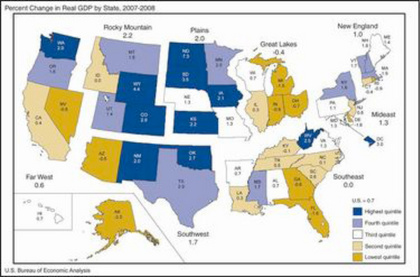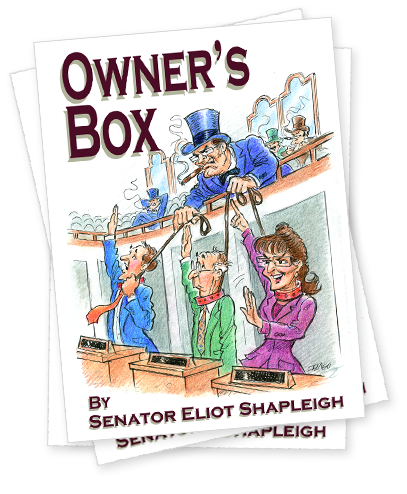Owner's Box
Chapter 6: The Model Red State
Texas ranks last among the states in the share of the population without health insurance, one-fifth of our children are impoverished, and we have among the lowest rates of educational attainment in the nation. So, why are right-wing economists, talk-show hosts and politicians hell-bent on painting Texas as the poster child for successful fiscal policy? One economist went so far as to suggest that the U.S. economy should start performing “more like Texas.”
This is yet another tall-tale, propagated by right-wingers like Rick Perry that has been carefully crafted to exploit the nation’s current economic woes in the name of limited government and lax regulation. Like most myths, this one’s heavy on the rhetoric but light on the facts.
First of all, contrary to what folks like Rick Perry would have you believe, so-called red states such as Texas are not all outperforming their blue brethren.
Just take a look at the following map, taken from an analysis by the Bureau of Economic Analysis of changes in state GDP from 2007-8. As you can see, of the 11 top-performing states, five are blue and six are red. Texas isn’t even on the list. It’s in the second tier of growth, joined by 10 other states, of which six are blue and four are red.
According to the most recent BEA data, Texas’s per-capita GDP actually fell $11 since 2007. In contrast, per-capita GDP in Massachusetts grew $700.
So, what’s propping up the “red-state myth” in Texas? It’s true that Texas is one of six states that did not run a budget deficit in the current recession. Yet, according to a new report from the National Conference of State Legislatures, out of 35 states that used federal stimulus funds to balance their budgets, Texas relied most heavily on the stimulus, using $12 billion in stimulus money to fill 96.7 percent of its budget gap.
It’s also worth noting that Texas was able to balance its budget more easily than other states is because of our meager safety net, which only serves a fraction of those in need. This makes it easier for Texas to balance its budget during a recession than, say, a state like California, where the safety net reaches a greater share of people in need and therefore expands more during an economic recession when need rises. In short, it’s not hard to reduce your effort, when you weren’t making much effort to begin with.
Texas may have balanced the ledger sheets this time around, but things won’t be so easy for future budgets, when Congress isn’t likely to be so willing to bail out Texas. If you add up the one-time revenue and federal stimulus money available to balance the budget for 2010-11, it amounts to 13.7% of current spending—or $12.7 billion that won’t be available for the 2012-13 budget cycle.
More importantly, Rick Perry built a structural deficit into the Texas budget year in and year out with a 2005 tax swap that fails to balance by $8B. In short, due to Perry’s budget malpractice, and Obama’s bailout no longer being available, Texas may face a deficit as high $19B in 2011.
What about the unemployment picture?—another thing Rick Perry likes to boast about. It’s true that Texas has a lower unemployment rate than other states, but the state is also hemorrhaging jobs at a faster pace, losing 266,300 jobs between January and July 2009. As of June 2009, more than quadruple the number of Texans were receiving unemployment benefits than in May 2008.
Moreover, Texas’ ability to help its jobless will be severely hampered in the year to come, due to Rick Perry’s reckless decision in March to turn down $555 million in federal stimulus money to expand unemployment assistance. This foolish move not only hurt unemployed workers, but also employers. The UI Trust Fund is about to run out of money, which means Texas employers will face a tax increase later this year to replenish the fund. This has forced Perry to go begging to the feds for a $650 million loan, which will be paid by Texas businesses and hard-working taxpayers already facing enormous hardships.
When he’s not borrowing money from the feds at taxpayers’ expense, Rick Perry also likes to brag that one out of every five jobs are created in Texas. If you listen closely, you’ll note he’s careful to quote the total number of jobs, rather than the rate of job creation. But you’d expect Texas to create more jobs just because of its sheer size compared to other states.
Incidentally, California creates even more jobs because it’s even bigger, and we all know how well it’s doing economically. When you look at the job growth rate,
Texas does not look as good as a lot of other Southern or Mountain states with similar economies that are heavily reliant on oil and gas revenue and service jobs.
Perhaps more telling is the kind of jobs Texas is creating—generally low-wage jobs in the service industry (such as restaurants, retail, or home health care) that don’t provide health insurance or other benefits. Population growth, rather than a strong economy, is the primary force behind this kind of job growth—as long as Texas continues its high birth rate and high domestic migration rate, we’ll continue to have an abundance of low-service, low-skilled jobs.
For sure, we aren’t losing manufacturing jobs at the same pace as other states. But that’s because Texas never had that many to begin with (except for industries that have to be here, like petrochemicals, or that have the market advantage of being closer to the customer, like Toyota). Again, you can’t lose what you never had.
All of this—stingy safety net, jobs that don’t pay the bills—contributes to Texas’ high poverty rate, despite its lower-than-average unemployment.
The sad truth is that Texas ranks last or near last in a host of key indicators. Take transportation for example. According to a report by Cambridge Systematics, a leading U.S. consulting group on infrastructure, Texas highway funds fall at least $8 billion short each year from meeting the basic needs of a growing state, or $256 billion by 2050, when the Texas population will have swelled by 49 million. This does not bode well for Texas’ future economic competitiveness. Having basic infrastructure is the key to a competitive economy—without the ability to move people and products, businesses and jobs will go to states and countries that can.
Lax regulation has also hurt Texas. While we have the highest level of carcinogens in the air of any state, Texans face the nation’s highest homeowner premiums. almost twice the national average. Meanwhile, profits for insurance companies continue to rise.
In a Wall Street Journal interview in August 2009, Perry bragged that ‘500,000 people moved to Texas between 2000 and 2006. Actually close to 1.5 million folks moved to Texas during that span. What he did not say was that 780,000 of those migrants were international migrants, roughly 70 percent coming from Mexico, folks escaping the destruction of that country’s agricultural sector as a result of NAFTA.
In contrast, only 468,000 or 18% of the total number of people that migrated to Texas were domestic migrants, those that usually have higher education levels and usually obtain higher paying jobs. Moreover, about 20% of these domestic migrants are refugees from Arizona and Oklahoma where draconian anti-immigration laws have driven immigrants to construction and agriculture jobs in Texas—not something Rick Perry will admit in his primary.
Based on the latest report from the U.S. Department of Labor, 42 states lost jobs in August, up from 29 in July, with the biggest net payroll cuts coming in Texas, Michigan, Georgia and Ohio. In fact, Texas lost 62,200 jobs as its unemployment rate rose to 8% in August for the first time in 22 years. The state’s leisure, construction and manufacturing industries were hardest hit, losing 35,500 jobs.
But don’t just take it from me. Here’s what Rick Perry’s own Select Commission on Higher Education and Global Competitiveness had to say about it: “Texas is not globally competitive. The state faces a downward spiral in both quality of life and economic competitiveness if it fails to educate more of its growing population (both young and adults) to higher levels of attainment, knowledge and skills.”
Red or blue, a state that fails to care for its sick, educate its young, or prepare its workforce to succeed is doomed, certainly not a model for other states or the nation to follow.

